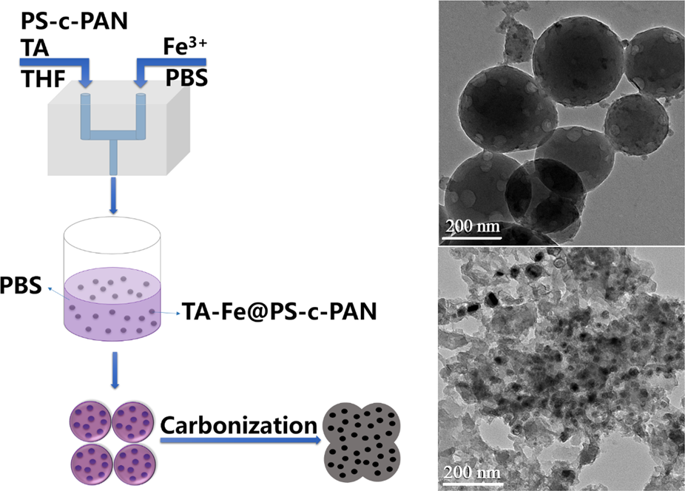Our official English website, www.x-mol.net, welcomes your feedback! (Note: you will need to create a separate account there.)
Pyrolysis of a flash nanoprecipitated tannic acid–metal@polymer assembly to create an electrochemically active metal@nanocarbon catalyst
Polymer Journal ( IF 2.8 ) Pub Date : 2020-01-17 , DOI: 10.1038/s41428-020-0305-1 Jianhong Wang , Zhijie Zhang , Jing Zhao , Rui Liu
Polymer Journal ( IF 2.8 ) Pub Date : 2020-01-17 , DOI: 10.1038/s41428-020-0305-1 Jianhong Wang , Zhijie Zhang , Jing Zhao , Rui Liu

|
Herein, hydrophobic tannic acid–iron (TA–Fe) coordination composites were encapsulated within polystyrene-copolyacrylonitrile (PS-c-PAN) nanospheres using the flash nanoprecipitation (FNP) technique. Carbon materials with uniform and dense distributions of metal NPs were obtained after carbonization under the protection and confinement of the polymer matrix. The as-prepared Fe and nitrogen codoped carbon materials exhibited enhanced electrocatalytic performance in the oxygen reduction reaction (ORR) and oxygen evolution reaction (OER). In addition, the catalytic ability of the carbon/metal composites could be affected by tuning the morphology and composition. TA–Fe@PS-c-PAN NPs were synthesized via a typical FNP procedure. During the process, the water solution containing Fe 3+ and the organic solution containing polymer and TA diffused into each other under turbulent mixing. As a result, the hydrophobic TA–Fe complex quickly formed and co-assembled into TA–Fe@PS-c-PAN NPs. After carbonization, carbon materials with uniformly dispersed metal NPs were finally and used as effective catalysts for oxygen reduction and evolution reactions. The flash nanoprecipitation (FNP) technique was employed to prepare polymer nanomaterial-entrapped metal precursors. The confinement function of polymers ensured a uniform distribution of metal NPs within the carbon matrix after carbonization. The morphology and electrocatalytic activities of the obtained catalysts could be varied by changing the processing parameters.
中文翻译:

快速纳米沉淀单宁酸-金属@聚合物组件的热解以产生电化学活性金属@纳米碳催化剂
在此,使用快速纳米沉淀(FNP)技术将疏水性单宁酸-铁(TA-Fe)配位复合材料封装在聚苯乙烯-共聚丙烯腈(PS-c-PAN)纳米球中。在聚合物基体的保护和约束下,碳化后得到金属纳米颗粒分布均匀且致密的碳材料。所制备的Fe和氮共掺杂碳材料在氧还原反应(ORR)和析氧反应(OER)中表现出增强的电催化性能。此外,碳/金属复合材料的催化能力可能会受到形貌和成分的调整的影响。TA-Fe@PS-c-PAN NPs 是通过典型的 FNP 程序合成的。在这个过程中,含有Fe 3+ 的水溶液和含有聚合物和TA 的有机溶液在湍流混合下相互扩散。结果,疏水性 TA-Fe 复合物迅速形成并共同组装成 TA-Fe@PS-c-PAN NPs。碳化后,具有均匀分散的金属纳米颗粒的碳材料最终被用作氧还原和析出反应的有效催化剂。采用快速纳米沉淀 (FNP) 技术制备聚合物纳米材料包埋的金属前体。聚合物的限制功能确保了碳化后金属纳米颗粒在碳基体中的均匀分布。通过改变工艺参数可以改变所得催化剂的形态和电催化活性。疏水性 TA-Fe 复合物迅速形成并共同组装成 TA-Fe@PS-c-PAN NPs。碳化后,具有均匀分散的金属纳米颗粒的碳材料最终被用作氧还原和析出反应的有效催化剂。采用快速纳米沉淀 (FNP) 技术制备聚合物纳米材料包埋的金属前体。聚合物的限制功能确保了碳化后金属纳米颗粒在碳基体中的均匀分布。通过改变工艺参数可以改变所得催化剂的形态和电催化活性。疏水性 TA-Fe 复合物迅速形成并共同组装成 TA-Fe@PS-c-PAN NPs。碳化后,具有均匀分散的金属纳米颗粒的碳材料最终被用作氧还原和析出反应的有效催化剂。采用快速纳米沉淀 (FNP) 技术制备聚合物纳米材料包埋的金属前体。聚合物的限制功能确保了碳化后金属纳米颗粒在碳基体中的均匀分布。通过改变工艺参数可以改变所得催化剂的形态和电催化活性。采用快速纳米沉淀 (FNP) 技术制备聚合物纳米材料包埋的金属前体。聚合物的限制功能确保了碳化后金属纳米颗粒在碳基体中的均匀分布。通过改变工艺参数可以改变所得催化剂的形态和电催化活性。采用快速纳米沉淀 (FNP) 技术制备聚合物纳米材料包埋的金属前体。聚合物的限制功能确保了碳化后金属纳米颗粒在碳基体中的均匀分布。通过改变工艺参数可以改变所得催化剂的形态和电催化活性。
更新日期:2020-01-17
中文翻译:

快速纳米沉淀单宁酸-金属@聚合物组件的热解以产生电化学活性金属@纳米碳催化剂
在此,使用快速纳米沉淀(FNP)技术将疏水性单宁酸-铁(TA-Fe)配位复合材料封装在聚苯乙烯-共聚丙烯腈(PS-c-PAN)纳米球中。在聚合物基体的保护和约束下,碳化后得到金属纳米颗粒分布均匀且致密的碳材料。所制备的Fe和氮共掺杂碳材料在氧还原反应(ORR)和析氧反应(OER)中表现出增强的电催化性能。此外,碳/金属复合材料的催化能力可能会受到形貌和成分的调整的影响。TA-Fe@PS-c-PAN NPs 是通过典型的 FNP 程序合成的。在这个过程中,含有Fe 3+ 的水溶液和含有聚合物和TA 的有机溶液在湍流混合下相互扩散。结果,疏水性 TA-Fe 复合物迅速形成并共同组装成 TA-Fe@PS-c-PAN NPs。碳化后,具有均匀分散的金属纳米颗粒的碳材料最终被用作氧还原和析出反应的有效催化剂。采用快速纳米沉淀 (FNP) 技术制备聚合物纳米材料包埋的金属前体。聚合物的限制功能确保了碳化后金属纳米颗粒在碳基体中的均匀分布。通过改变工艺参数可以改变所得催化剂的形态和电催化活性。疏水性 TA-Fe 复合物迅速形成并共同组装成 TA-Fe@PS-c-PAN NPs。碳化后,具有均匀分散的金属纳米颗粒的碳材料最终被用作氧还原和析出反应的有效催化剂。采用快速纳米沉淀 (FNP) 技术制备聚合物纳米材料包埋的金属前体。聚合物的限制功能确保了碳化后金属纳米颗粒在碳基体中的均匀分布。通过改变工艺参数可以改变所得催化剂的形态和电催化活性。疏水性 TA-Fe 复合物迅速形成并共同组装成 TA-Fe@PS-c-PAN NPs。碳化后,具有均匀分散的金属纳米颗粒的碳材料最终被用作氧还原和析出反应的有效催化剂。采用快速纳米沉淀 (FNP) 技术制备聚合物纳米材料包埋的金属前体。聚合物的限制功能确保了碳化后金属纳米颗粒在碳基体中的均匀分布。通过改变工艺参数可以改变所得催化剂的形态和电催化活性。采用快速纳米沉淀 (FNP) 技术制备聚合物纳米材料包埋的金属前体。聚合物的限制功能确保了碳化后金属纳米颗粒在碳基体中的均匀分布。通过改变工艺参数可以改变所得催化剂的形态和电催化活性。采用快速纳米沉淀 (FNP) 技术制备聚合物纳米材料包埋的金属前体。聚合物的限制功能确保了碳化后金属纳米颗粒在碳基体中的均匀分布。通过改变工艺参数可以改变所得催化剂的形态和电催化活性。



























 京公网安备 11010802027423号
京公网安备 11010802027423号